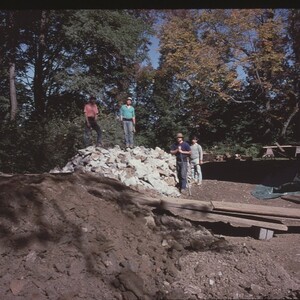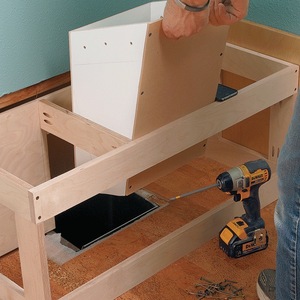I *know* I saw something about this new product in one of the mags I get recently. And I can find references to such a product by googling, but nothing substantial.
Any idea on price or availability? My Mom and Dad are finishing their vacation house basement on Cape Cod and are nearing the drywall finishing phase after inspections are done – I’m thinking a nice Father’s Day treat would be a neato product like this stuff – since I know from first hand experience what a nasty job it can be – especially in the heat of summer.
Edit: I guess I should also ask “does this stuff work”?
Thanks, PJ
Edited 6/7/2006 4:20 pm ET by pjmcgarvey


















Replies
You saw the review in FHB - I've used the stuff and it's true to it's word. Just remember that it still creates dust, the dust just doesn't float around in the air.
I think at this point you can only get it at the Home Depot - at the time we wrote it up, was $13.50 per bucket.
Justin Fink - FHB Editorial
Your Friendly Neighborhood Moderator
Instead of the joint compound, why don't you get your parents a drywall finisher? The type that never needs to sand, and you won't have any dust.
Bryan, tell me more. Not sure what you mean.
Really, really, really good drywall finishers can tape and mud in such a manner that no sanding is needed. My father had one working for him, but it took four coats to do it. And these were institutional buildings, so probably metal studs in most cases.
Most of the new construction out here is just drywall with a texture coat sprayed or troweled right over the tape and filled screw holes. I suppose a buyer could spec flat walls and ceilings, but it's the exception by a long shot.Sanding? What sanding? We don't need no stinking sanding, they will buy these stucco boxes anyway!
To reduce drywall dust Don't Sand So Much. Instead of sanding between dry coats , just take a dry straight trowel and scrape off the extra lumps, bumps and ridges. Scraping saves me 100's of hours of sanding.
*I* know how to do drywall work, question is, do my parents? I figure they make this stuff for a reason, b/c as good as you think you are at something, there's always a challenge buried somewhere. I know that if my Dad were to use this product, it might make the whole process go faster 'in his mind' b/c he was using 'new technology' to do it.
Though I've gotten better over the years, I still find that a little bit of sanding can go a long way, but even that little bit - is not so fun when all you want to do is slap the paint on there and call it done.
PJ
i find that pole sanding between coats and after all the coating is done is what makes the surfaces not just smooth but also true....it seems as if the joint compound can dry unevenly...especially in the fill coats. There are those drywall sponges that one would use wet but i'm thinking it doesn't create flat, only smooth. "I hate quotations. Tell me what you know" Ralph Waldo Emerson
For the last three years i've been using a block that hooks up to my shop-vac for drywall sanding. Almost no dust, though the system I use requires mesh screens rather than regular sandpaper, which dosent give quite such a fine finish.
maybe one has to then polish with the wet drywall sponge after the mesh vac-sander? That might be the ticket."I hate quotations. Tell me what you know" Ralph Waldo Emerson
Sungod is on the money here.
Can someone tell me why it is necessary to sand between coats? If there is another coat being applied on top why not just knock it down before recoating?
When finishing isnt it only the edge that needs to be feathered? Why would all of a seam need to be sanded? By the finish coat the seam should be flat and smooth.Parkinson's Law: 'Work expands so as to fill the time available for its completion.'
Because there are people that try to put all 3 coats on at one time and then a little more, just to be sure.Three weeks ago I was suppose to spend 4 days removing wallpaper and paint. It was only part of the job and I was just doing "what could be done at the time".One of the rooms was the living room ceiling, but not the walls. But someone had gone through the ceiling adn the carpenter that has been doing some of the work there patched it and put the first coat of mud on it.But the repair was also on the wall. So it needed painting too. This was on monday, but the carpenter was not suppose to be back until wensday (and later thursday).To keep the job going I said that I would finish the repair.In retrospect I should have taken a wet sponge and removed most of what he had put on. I sanded and sanded and put on 4 more small coats, but still left a small bump. And yesterday I was back fixing some receptacles in the basement where DW had been done several years earlier and no one moved the receptacles out.I noticed some mud on the DW in the stairwell. About 3/16" ridge.
"Because there are people that try to put all 3 coats on at one time and then a little more, just to be sure."
Bill you are right. If you can use a setting compound, a product like Durabond (I happen to like 90) then you can apply multiple coats in a day. If you aren't familiar with setting compound, it means that there is a drying agent in the product. Durabond makes several from 15 to 120 where the number is the number of minutes till it sets. Then top coat with bucket mud.
For those of you who work on old lathe and plaster jobs there is a product out there called Pro Kote made by Tuff Kote that will change your life. No BS. Lay down some of their acrylic and press into it a fine mesh fiberglass and finish. Thats it. Try it out if you can locate it. Just to be clear, this is for crack repairs and not new drywall.
Parkinson's Law: 'Work expands so as to fill the time available for its completion.'
I use a 1/4 sheet plam sander with a 1" vacuum hook up. I use a 1 inch flexible hose that connects to the 2" hose on my shop vac. You need to use sanding screens to make this work. Most of hte dust is pulled into the vacuum
Messing with the power cord and the hose is a bit of a pain, but worth it to not have the dust.